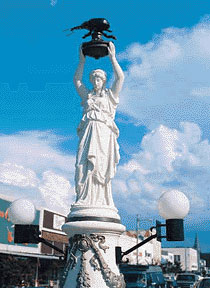1. Boll Weevils - The Boll Weevil Festival, Enterprise Alabama
The Boll Weevil Festival is one of the most popular times to visit the memorial, and to enjoy a range of entertainment, and of course great Southern food.
The festival is held every October in downtown Enterprise. It features arts, crafts, children’s activities, a farmers’ market and more.
The Enterprise Chamber of Commerce is always happy to help tourists with information about the festival, and to provide extra tips on what to do while they’re in town.

2. Termites
They have termite mound appreciation:

3. Black Widows - November 4th.
Boll Weevil Honored
On December 11, 1919, the citizens of Enterprise, Alabama erected a monument to the boll weevil, the pest that devastated their fields but forced residents to end their dependence on cotton and to pursue mixed farming and manufacturing. A beetle measuring an average length of six millimeters, the insect entered the United States via Mexico in the 1890s and reached southeastern Alabama in 1915. It remains the most destructive cotton pest in North America.


King Cotton, 1907.
Taking the Long View, 1851-1991
The infestation led to the introduction of the peanut—an alternative crop popularized by the Tuskegee Institute's George Washington Carver. Peanut cultivation not only returned vital nutrients to soils depleted by cotton cultivation, but also proved a successful cash crop for local farmers.


J.A. Johnson's Oldest Daughter Picking Cotton, Statesville, North Carolina.
Marion Post Wolcott, photographer, circa October 1939.
FSA-OWI Photographs, 1935-1945
By mid-1921, the boll weevil had entered South Carolina. In a 1939 interview for the Federal Writers' Project, South Carolina native Mose Austin recalled that his employer was adamant "he don't want nothin' but cotton planted on de place; dat he in debt and hafter raise cotton to git de money to pay wid." Austin let out a long guffaw before recounting, De boll weevil come…and, bless yo' life, dat bug sho' romped on things dat fall." Austin remembered that the following spring, his employer insisted on planting cotton in spite of warnings from his wife, his employees, and government agricultural experts:
De cotton come up and started to growin', and, suh, befo' de middle of May I looks down one day and sees de boll weevil settin' up dere in de top of dem little cotton stalks waitin' for de squares to fo'm. So all dat gewano us hauled and put down in 1922 made nuttin' but a crop of boll weevils. "Always Agin It," Place Chapin, South Carolina
John L. Dove, interviewer, January 24, 1939.
American Life Histories, 1936-1940
The next year, Austin's employer tried the same ill-fated experiment. Ultimately, the man lost his farm and moved with his disgruntled wife to California.
The boll weevil contributed to the economic woes of Southern farmers during the 1920s—a situation exacerbated by the Great Depression. As late as 1939, Farm Security Administration photographer Marion Post Wolcott, on assignment in Wake County, noted the destructive presence of the pest in the fields of North Carolina.
"Boll Weevil," Irvin "Gar Mouth" Lowry, Willie "Red Eye" Williams, May 20, 1939.
Florida Folklife from the WPA Collections






